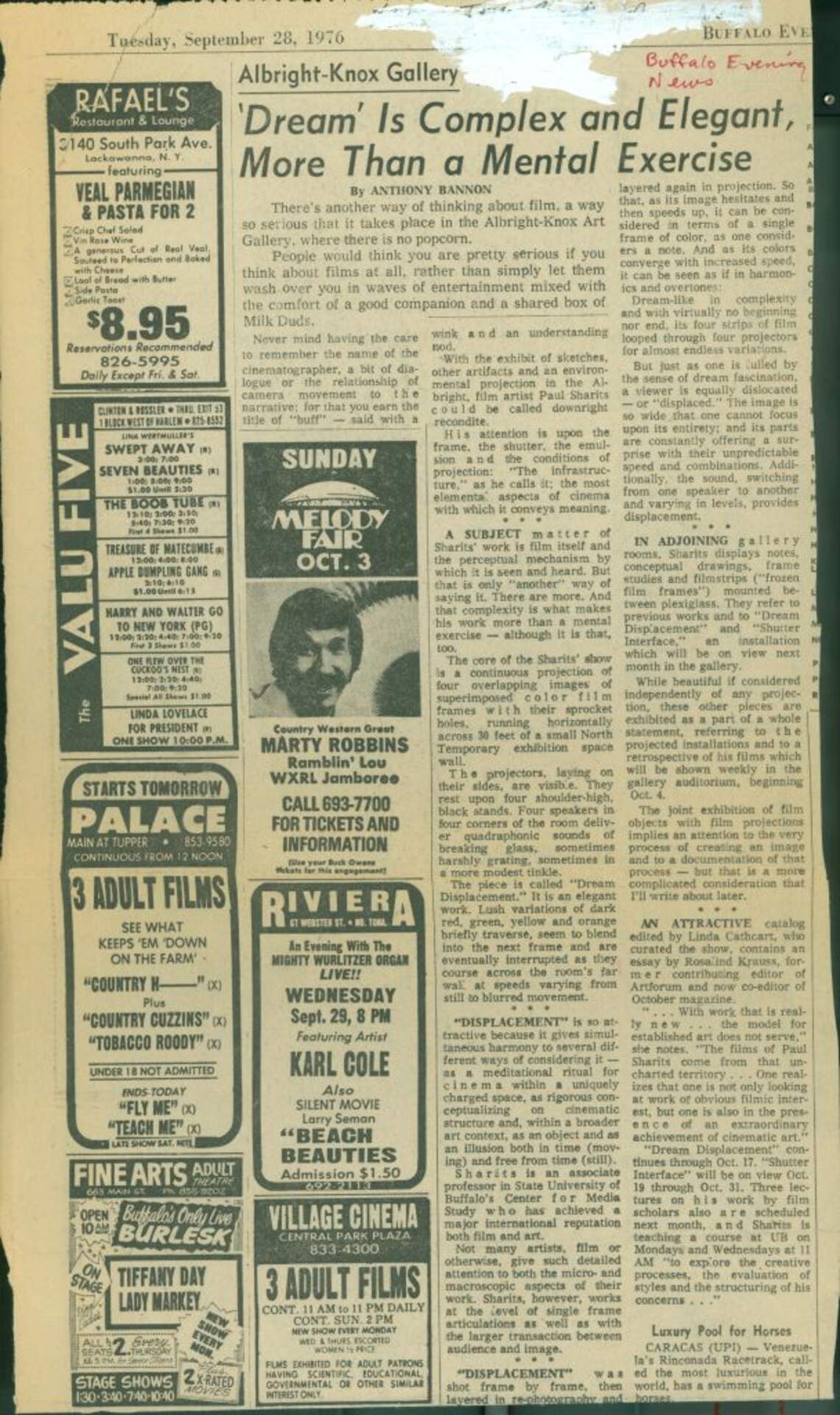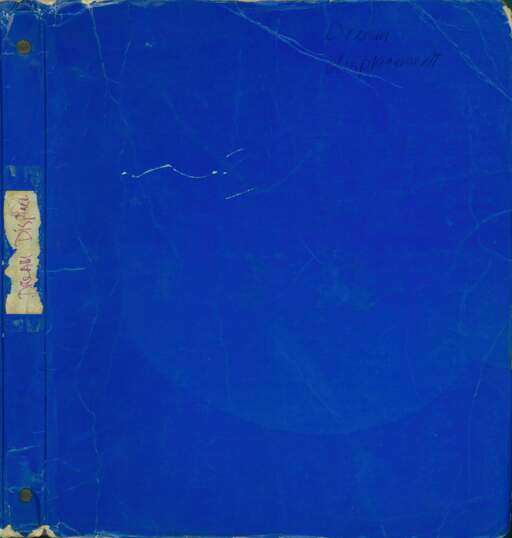Paul Sharits (1943-1993)'Dream' Is Complex and Elegnat, More Than a Mental Exercise
typed on newsprint
13 1/4 x 7 3/4 inches
Gift of Christopher and Cheri Sharits, 2006
Albright-Knox Gallery Buffalo Evening News
‘Dream’ Is Complex and Elegant, More Than a Mental Exercise
By Anthony Bannon
There’s another way of thinking about film, a way so serious that it takes place in the Albright-Knox Art Gallery, where there is no popcorn.
People would think you are pretty serious if you think about films at all, rather than simply let them wash over you in waves of entertainment mixed with the comfort of a good companion and a shared box of Milk Duds.
Never mind having the care to remember the name of the cinematographer, a bit of dialogue or the relationship of camera movement to the narrative: for that you earn the title of “buff”—said with a wink and an understanding nod.
With the exhibit of sketches, other artifacts and an environmental projection in the Albright, film artist Paul Sharits could be called downright recondite.
His attention is upon the frame, the shitter, them emulsion, and the conditions of projection: “The infrastructure,” as he calls it: the most elemental aspects of cinema with which it conveys meaning.
A SUBJECT matter of Sharits’ work is film itself and the perceptual mechanism by which it is seen and heard. But that is only ‘another” way of saying it. There are more. And that complexity is what makes his work more than a mental exercise—although it is that, too.
The core of the Sharits’ show is a continuous projection of four overlapping images of superimposed color film frames with their sprocket holes, running horizontally across 30 feet of a small North Temporary exhibition space wall.
The projectors, laying on their sides, are visible. They rest upon four shoulder-high black stands. Four speakers in four corners of the room deliver quadraphonic sounds of breaking glass, sometimes harshly grating, sometimes in a more modest tinkle.
The piece is called “Dream Displacement.” It is an elegant work. Lush variations of dark red, green, yellow, and orange briefly traverse, seem to blend into the next frame and are eventually interrupted as they course across the room’s far wall at speeds varying from still to blurred movement.
“DISPLACEMENT” is so attractive because it fives simultaneous harmony to several different ways of considering it—as a meditational ritual for cinema within a uniquely charged space, as rigorous conceptualizing on cinematic structure and, within a broader art context, as an object and as an illusion both in time (moving) and free from time (still).
Sharits is an associate professor in State University of Buffalo’s Center for Media Study who has achieved a major international reputation both film and art.
Not many artists, film or otherwise, give such detailed attention to both the micro-and macroscopic aspects of their works. Sharits, however, works at the level of single frame articulations as well as with the larger transaction between audience and image.
“DISPLACEMENT” was shot frame by frame, the layered in re-photography and layered again in projection. So that, as its image hesitated and then speeds up, it can be considered in terms of a single frame of color, as one considers a not. And as its colors converge with increased speed, it can be seen as if in harmonics and overtones:
Dream-like in complexity and with virtually no beginning nor end, its four strips of film looped through four projectors for almost endless variations.
But just as one is lulled by the sense of dream fascination, a viewer is equally dislocated—or “displaced.” The image is so wide that one cannot focus upon its entirety; and its parts are constantly offering a surprise with their unpredictable speed and combinations. Additionally, the sound, switching from one speaker to another and varying in levels, provides displacement.
IN ADJOINING gallery rooms, Sharits displays notes, conceptual drawings, frame studies and filmstrips (“frozen film frames”) mounted between plexiglass. They refer to previous works and to “Dream Displacement” and “Shutter Interface,” an installation which will be shown weekly in the gallery auditorium, beginning Oct. 4.
The joint exhibition of film objects with film projections implies an attention to the very process of creating an image and to a documentation of that process—but that is a more complicated consideration that I’ll write about later.
AN ATTRACTIVE catalog edited by Linda Cathcart, who curated the show, contains an essay by Rosalind Krauss, former contributing editor of Artform and now co-editor of October magazine.
“..With work that is really new…the model for established art does not serve,” she notes. “The films of Paul Sharits come from that uncharted territory…One realizes that one is not only looking at work of obvious filmic interest, but one is also in the presence of an extraordinary achievement of cinematic art.”
“Dream Displacement” continues through Oct. 17. “Shutter Interface” will be on view Oct. 19 through Oct. 31. Three lectures also are scheduled next month, and Sharits is teaching a course at UB on Mondays and Wednesdays at 11 AM “to explore the creative processes, the evaluation of styles and the structuring of his concerns…”


